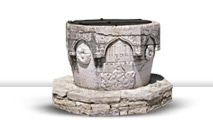
- Sečovlje Salt Pans - Dragonja River Valley
- Sv. Peter - Nova vas - Padna
- Pomjan - Nature Park: Karst Edge - Socerb
- Črni Kal - Osp - Kubed
- Momjan - Grožnjan - Pietrapelosa - Mirna
- Baštija - Kostanjica - Parenzana
- Oprtalj - Završje - Livade - Zrenj
- Istarske toplice - Motovun Forest - Višnjan
- Cave Mramornica - Feštini Kingdom - Cave Baredine
- Lim Bay - Kloštar - Kontija - Dvigrad
- Kanfanar - Bale - Palud - Vodnjan -Islands Brijuni - Fažana
- Svetvinčenat - Tinjan - Pićan - Gračišće
- Belaj - Šumber - Kožljak - Paz
- Čepićko Field - Kršan - Boljun Castle - Lupoglav
- Plomin - Kvarner Gulf - Brseč
- Nature park Učka - Mošćenice
Svetvinčenat - Tinjan - Pićan - Gračišće
Pićan
Owing to its strategically important location, it was the site of a prehistoric hill-fort, and in Roman times Pićan was a military stronghold. From the 6th - 18th cc. it was the seat of the only diocese in the interior of Istria with 12 parishes, and due to such a connection with the Roman Church it always had a significant place and great power in Central Istria.
At the time of Byzantine rule Pićan was the administrative center of Central Istria. In the 10th c. both Pazin and Pićan were under the Patriarchs of Aquileia, who in the 12th c. granted the Pićan fief to the founder of the County of Pazin, so as part of it, Pićan came under the rule of the Habsburgs in the 14th c.
The historical sights include the partly preserved medieval walls and town gate from the 14th c., with the one-time Bishop's Palace next to it. Also, the small Church of St. Roch from the 17th c., St. Michael's Church at the cemetery with frescoes from the 15th c. and the Parish Church erected on the site of a cathedral dating from the 14th c.
The belfry, 48 meters high, was constructed at the end of the 19th c. and is among the tallest ones in Istria. Next to it is a stone measure which was once used for collecting the tithe. Some of the precious remains include a valuable organ, many relics, inscriptions and other objects testifying to the rich period of the seat of the diocese.


















